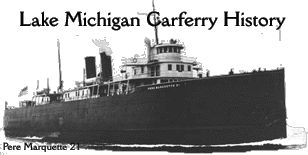

When the S.S. Badger set sail from Ludington, Michigan in May 1992, following a gala christening, it signaled a return of something that had been a colorful and interwoven part of Lake Michiganhistory for more than a century. The Lake Michigan car ferry was back.
Indeed, the history of freight and passenger steamship service across Lake Michigan has been a part of the history of the region and of the country itself since 1875, the year the Flint and Pere Marquette Railway chartered the 175 foot long side-wheeler steamer John Sherman to shuttle grain, packaged freight and passengers between Ludington, Michigan and Sheboygan, Wisconsin. Seventeen years later, James Ashley, former governor of Montana and then president of the Ann Arbor Railroad, pushed cross-lake service into the 2Oth century when he ordered the 260 foot wooden hulled Ann Arbor 1and loaded it with railroad cars. Having proved that a car ferry was a viable alternative to shipping loose bulk cargo, the Lake Michigan car ferry service was born.
During this period, the Flint and Pere Marquette Railway went ahead with plans to develop a similar fleet of car ferries. Capitalizing on Ann Arbor's sucesses and failures, the railroad placed an order to design the first steel hulled cross-lake car ferry. Launched in 1896, and ready for service by February 1897, the ship was named Pere Marquette, after the famed Jesuit missionary. The 350 foot long vessel was an immediate success and proved to be a fine ice-breaker. So significant was the design that it set the standard for many railroad ferries built in the 2Oth century on the Great Lakes and abroad.
Through the years, the car ferry fleet, as with its owners, expanded and retrenched, as economic times demanded, but never faltered in its service to the people and businesses of the upper Great Lakes. With the outbreak of World War I, cross-lake freight traffic increased substantially as was the case with most of the nation's rail systems. So in the summer of 1918 the U.S. Railroad Administration created the Lake Michigan Car Ferry Association, bringing the 11 vessels of the Ann Arbor, Grand Trunk and Pere Marquette railroads under its supervision. It was anticipated that the three rival fleets could pool their ferries to provide faster and more efficient service to aid in the war effort, which proved to be true. In 1920, the car ferries were returned to their respective owners.
The 1920's were a prosperous time for the United States and for the car ferries of Lake Michigan. Several new ferries were ordered by all three railroads, including two that were delivered just in time for the Great Depression. While the decrease in commerce caused by the Depression forced older tonnage off the Lake, not all of the events were negative. In 1931, the City of Flint 32, one the ships of the Pere Marquette fleet, set a world marine record for miles traveled by by traveling 101,000 miles on 1,010 crossings of Lake Michigan ( this record was later broken by the liner Europa -- by a small margin).
In 1952, the final additions were made to the Ludington-based fleet. Hailed as the "Twin Queens of the Lakes" the S.S. Spartan and the S.S. Badger, each at a cost of $5 million, were 410 feet in length--the largest Great Lakes car ferries ever built--and had the most superior passenger accommodations ever witnessed. The year 1955 was the zenith of the Lake's ferries; during that year they ferried 205,000 passengers and 204,460 freight cars in 6,986 crossings of Lake Michigan.
By 1975, the C&O railroad, which had purchased the Pere Marquette Railway some years earlier, was no longer interested in operating car ferries, citing the rising costs of vessel upkeep, increasing labor and fuel costs, and advances in railroad technology. After a long and bitter abandonment proceeding before the Interstate Commerce Commission, the C&O finally exited the car ferry business in 1983 when it sold its three remaining ferries to the newly created Michigan-Wisconsin Transportation Company. The new company struggled to keep the ferries afloat, but summer passenger and auto revenues were not enough to offset the lack of freight traffic and, on November 16, 1990, the S.S. Badger, the last of the Lake Michigan car ferries, set sail on its final trip.
The Lake was not to be without its ferries for long, however. In July 1991, Charles Conrad, a Ludington native and retired entrepreneur, purchased the Badger, its sister ship the Spartan and the City of Midland. It was a fitting return to a boyhood love. Conrad, the son of a chief engineer for the former Pere Marquette Railway, accompanied his father on many cross-lake trips as a youth and grew to love the car ferries along the way. Conrad, who died in February 1995, said, "I always believed that the ferries would be forever a part of Ludington. The ferries are a part of Ludington. They've been on the Lake for the past hundred years, and I want to do whatever I can to assure they'll be running for the next hundred."
Conrad was succeeded by Robert A. Manglitz who currently serves as President and Chief Executive officer of the Lake Michigan Carferry Service. The S.S. Badger sails between Ludington, Michigan and Manitowoc, Wisconsin.
Thom Hawley
Director of Public Relations
Photo of Charles Conrad courtesy of Thom Hawley.
Background made from a drawing of the John Sherman.
Since
03/28/97